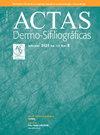Carcinomas basocelulares múltiples. Patocronia y factores predisponentes
IF 2.8
Q1 DERMATOLOGY
引用次数: 0
Abstract
Introduction
Between 29% and 53% of the patients who develop basal cell carcinoma (BCC) will develop new BCCs.
Objectives
Current objectives are to analyze the proportion and basic characteristics of patients who develop BCC > 1, to delineate the concept of multiple BCC (mBCC) and be able to identify the factors associated with its development, and analyze its timeframe.
Patients and method
We conducted a retrospective observational study including all patients diagnosed with sporadic BCC from January 1st, 2014 through December 31st, 2014 at a tertiary referral center. Data included dates of BCCs, gender, age and histology of the first BCC, and the presence of BCC > 1 at the initial appointment (cluster+). mBCC was defined as a patient who developed a series of BCCs > the 75th percentile of the series.
Results
A total of 758 patients (51.2% men), were included. After a median follow-up of 100 months, 52.8% of the patients developed BCC > 1. The 75th percentile of the number of BCCs was 3. Factors associated to mBCCs included being cluster+ (OR, 5.6; 95%CI, 3.2 – 9.7), being men (OR, 3.1; 95%CI, 2.0 – 4.8) and diagnosed with the first BCC between ages of 50 and 80 years (OR, 2.1; 95%CI, 1.3 – 3.5). After 5 years, 54% of patients exhibiting these 3 factors developed mBCC. The estimated median time to mBCC was 38.00 months (95%CI, 0 – 79.71).
Conclusions
A quarter of patients who Exhibit 1 BCC eventually develop 4 or more BCCs. Analyzing routine parameters may help identify individuals at a higher risk of developing mBCC and predict its timeframe.

多发性基底细胞癌。时间表和潜在的风险因素。
29% - 53%的基底细胞癌(BCC)患者会发展为新的基底细胞癌。目的:目前的目标是分析BCC患者的比例和基本特征bbb1,描述多发性BCC (mBCC)的概念,并能够识别与其发展相关的因素,并分析其时间框架。患者和方法:我们进行了一项回顾性观察研究,纳入了2014年1月1日至2014年12月31日在三级转诊中心诊断为散发性BCC的所有患者。数据包括BCC的日期,性别,年龄和第一个BCC的组织学,以及首次预约时BCC bbb1的存在(簇+)。mBCC被定义为出现一系列bcc的患者,这些bcc达到系列的第75个百分位。结果:共纳入758例患者,其中男性51.2%。中位随访100个月后,52.8%的患者发展为BCC。bcc数量的第75百分位数为3。与mbcc相关的因素包括集群+ (OR, 5.6;95%CI, 3.2 - 9.7),为男性(OR, 3.1;95%CI, 2.0 - 4.8),并在50 - 80岁之间被诊断为首次BCC (OR, 2.1;95%ci, 1.3 - 3.5)。5年后,出现这3种因素的患者中有54%发展为mBCC。估计到mBCC的中位时间为38.00个月(95%CI, 0 - 79.71)。结论:1 / 4表现为1型BCC的患者最终发展为4个或更多BCC。分析常规参数可能有助于识别发展为mBCC的高风险个体并预测其时间框架。
本文章由计算机程序翻译,如有差异,请以英文原文为准。
求助全文
约1分钟内获得全文
求助全文
来源期刊

Actas dermo-sifiliograficas
DERMATOLOGY-
CiteScore
1.90
自引率
9.40%
发文量
473
审稿时长
56 weeks
期刊介绍:
Actas Dermo-Sifiliográficas, publicación Oficial de la Academia Española de Dermatología y Venereología, es una revista de prestigio consolidado. Creada en 1909, es la revista mensual más antigua editada en España.En 2006 entró en Medline, y hoy resulta imprescindible para estar al día sobre la dermatología española y mundial.
 求助内容:
求助内容: 应助结果提醒方式:
应助结果提醒方式:


